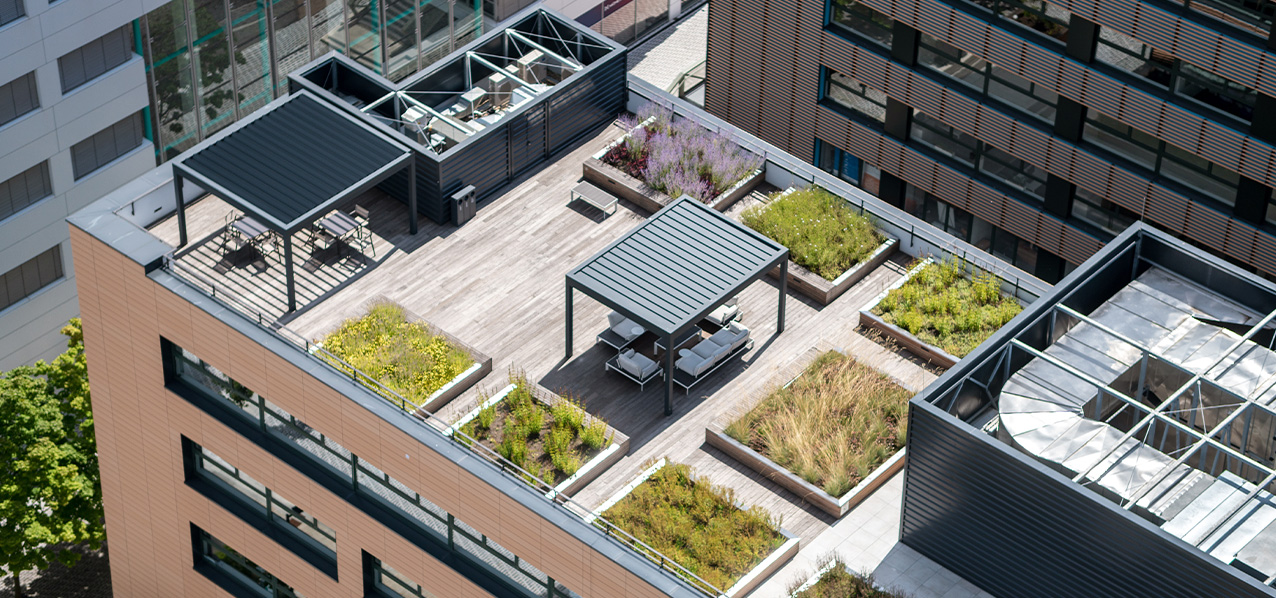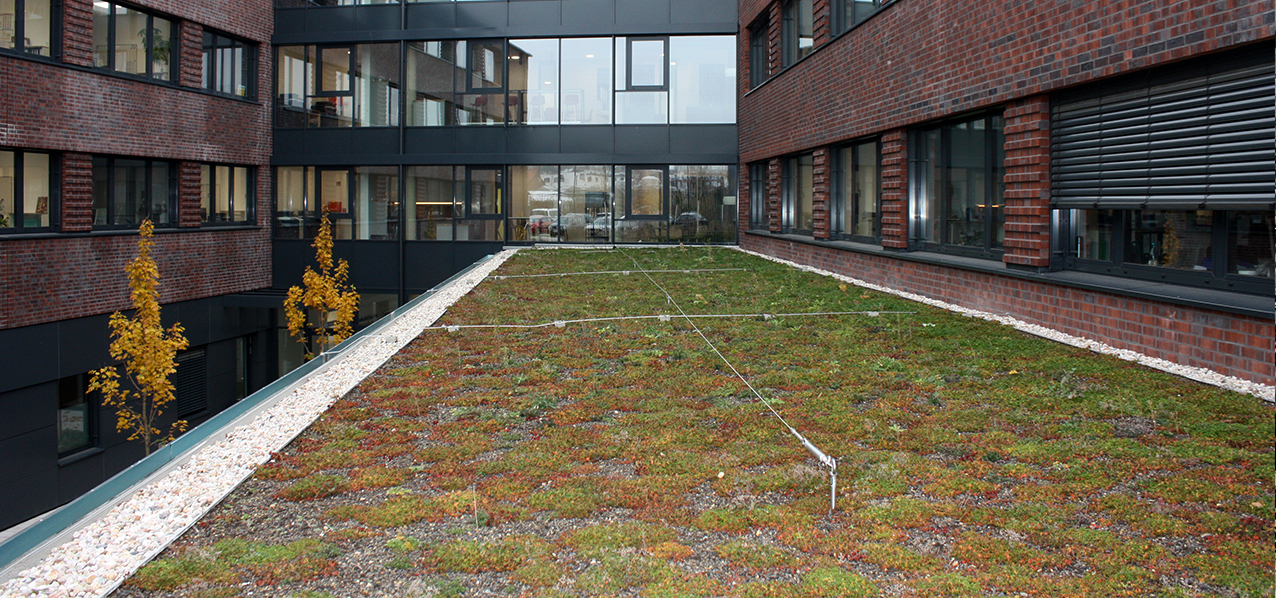Quality criteria – Substrates for green roofs
RAL-certified substrates for green roofs
The importance of the substrate layer of green roof systems has grown steadily over the past few years. The proportion of intensive green roofs is increasing year by year.
Special material is normally used to build up the different substrate layers (for support and nutrition) for roof-top plantings. Conventional soils would be too heavy. Substrates for green roofs are intricately mixed from specific constituents such as lava, expanded clay granules, bark humus, etc. Above all, the thickness and physical properties of the vegetation support layer play a decisive role in how well the plants used are supplied with nutrients and water. In other words, the quality of the substrate constituents plays a crucial role.
Gütegemeinschaft Substrate für Pflanzen e.V. monitors quality assurance also for substrates for green roofs. Right up until today, the most varied types of substrates have been developed for the specific uses (see overview of quality criteria), because each substrate has to meet different requirements.
Functions and properties of substrates for green roofs:
- light weight
- well-balanced provision of nutrients, water and air
- technical suitability for roofs
- guaranteed drainage of excess water
- good water holding capacity
The functions green roof substrates have to perform can be allocated to different functional layers (multi-layer construction) or combined in a single layer (single-layer construction).
Quality criteria
RAL Quality Assurance was dawn up in accordance with the FLL regulations “Richtlinien für die Ausführung und Pflege von Dachbegrünungen” (“Directives for Green Roof Planning, Implementation and Maintenance”) (FLL =Forschungsgesellschaft Landschaftsentwicklung, Landschaftsbau e.V. / German Research Society for Landscape Development and Landscape Design). Gütegemeinschaft Substrate für Pflanzen e.V. significantly expanded the FLL requirements by adding extensive and regular self-monitoring and external monitoring as well as the obligation to declare all constituents and particle sizes.
RAL Quality Assurance for Substrates for Green Roofs not only incorporates the quality specifications recommended by FLL, but also provides for monitoring environmental parameters, such as heavy metals, arsenic, nitrate and hydrocarbons. Using RAL-certified substrates for green roofs prevents polluted water from draining off them. The Quality Assurance also incorporates the requirements of the German Fertilizer Ordinance (DüMV) by stipulating regular checks of nutrient and heavy metal contents. Substrates for green roofs must be declared accordingly.
Download quality criteria substrates for green roofs
INTENSIVE GREEN ROOF SUBSTRATES FOR MULTI-LAYER CONSTRUCTION (RAL-GZ 250/6-1) – QUALITY CRITERIA
INTENSIVE GREEN ROOF SUBSTRATES FOR SINGLE-LAYER CONSTRUCTION (RAL-GZ 250/6-2) – QUALITY CRITERIA
EXTENSIVE GREEN ROOF SUBSTRATES FOR MULTI-LAYER CONSTRUCTION (RAL-GZ 250/6-3) – QUALITY CRITERIA
EXTENSIVE GREEN ROOF SUBSTRATES FOR SINGLE-LAYER CONSTRUCTION (RAL-GZ 250/6-4) – QUALITY CRITERIA
GRANULAR DRAINAGE MATERIAL (RAL-GZ 250/6-5) – QUALITY CRITERIA
REQUIREMENTS AS TO ENVIRONMENTAL RELEVANCE
FOLDER RAL QUALITY ASSURANCE SUBSTRATES FOR GREEN ROOFS AND SUBSTRATES FOR TREE PLANTINGS
Quality assurance exists for the following types of substrates for green roofs:

Example of intensive green roof

Example of extensive green roof
Quality criteria – Substrates for green roofs
RAL-certified substrates for green roofs
The importance of the substrate layer of green roof systems has grown steadily over the past few years. The proportion of intensive green roofs is increasing year by year.
Special material is normally used to build up the different substrate layers (for support and nutrition) for roof-top plantings. Conventional soils would be too heavy. Substrates for green roofs are intricately mixed from specific constituents such as lava, expanded clay granules, bark humus, etc. Above all, the thickness and physical properties of the vegetation support layer play a decisive role in how well the plants used are supplied with nutrients and water. In other words, the quality of the substrate constituents plays a crucial role.
Gütegemeinschaft Substrate für Pflanzen e.V. monitors quality assurance also for substrates for green roofs. Right up until today, the most varied types of substrates have been developed for the specific uses (see overview of quality criteria), because each substrate has to meet different requirements.
Functions and properties of substrates for green roofs:
- light weight
- well-balanced provision of nutrients, water and air
- technical suitability for roofs
- guaranteed drainage of excess water
- good water holding capacity
The functions green roof substrates have to perform can be allocated to different functional layers (multi-layer construction) or combined in a single layer (single-layer construction).
Quality criteria
RAL Quality Assurance was dawn up in accordance with the FLL regulations “Richtlinien für die Ausführung und Pflege von Dachbegrünungen” (“Directives for Green Roof Planning, Implementation and Maintenance”) (FLL =Forschungsgesellschaft Landschaftsentwicklung, Landschaftsbau e.V. / German Research Society for Landscape Development and Landscape Design). Gütegemeinschaft Substrate für Pflanzen e.V. significantly expanded the FLL requirements by adding extensive and regular self-monitoring and external monitoring as well as the obligation to declare all constituents and particle sizes.
RAL Quality Assurance for Substrates for Green Roofs not only incorporates the quality specifications recommended by FLL, but also provides for monitoring environmental parameters, such as heavy metals, arsenic, nitrate and hydrocarbons. Using RAL-certified substrates for green roofs prevents polluted water from draining off them. The Quality Assurance also incorporates the requirements of the German Fertilizer Ordinance (DüMV) by stipulating regular checks of nutrient and heavy metal contents. Substrates for green roofs must be declared accordingly.
Download quality criteria substrates for green roofs
INTENSIVE GREEN ROOF SUBSTRATES FOR MULTI-LAYER CONSTRUCTION (RAL-GZ 250/6-1) – QUALITY CRITERIA
INTENSIVE GREEN ROOF SUBSTRATES FOR SINGLE-LAYER CONSTRUCTION (RAL-GZ 250/6-2) – QUALITY CRITERIA
EXTENSIVE GREEN ROOF SUBSTRATES FOR MULTI-LAYER CONSTRUCTION (RAL-GZ 250/6-3) – QUALITY CRITERIA
EXTENSIVE GREEN ROOF SUBSTRATES FOR SINGLE-LAYER CONSTRUCTION (RAL-GZ 250/6-4) – QUALITY CRITERIA
GRANULAR DRAINAGE MATERIAL (RAL-GZ 250/6-5) – QUALITY CRITERIA
REQUIREMENTS AS TO ENVIRONMENTAL RELEVANCE
FOLDER RAL QUALITY ASSURANCE SUBSTRATES FOR GREEN ROOFS AND SUBSTRATES FOR TREE PLANTINGS
Quality assurance exists for the following types of substrates for green roofs:

Example of intensive green roof

Example of extensive green roof



